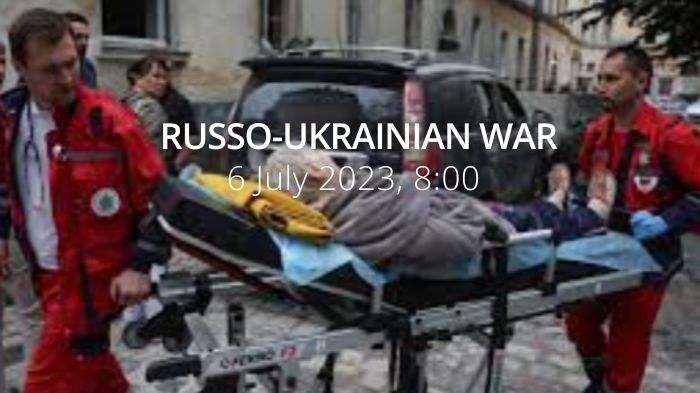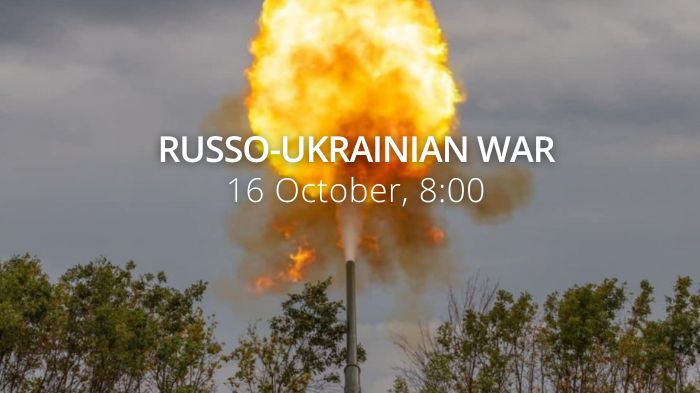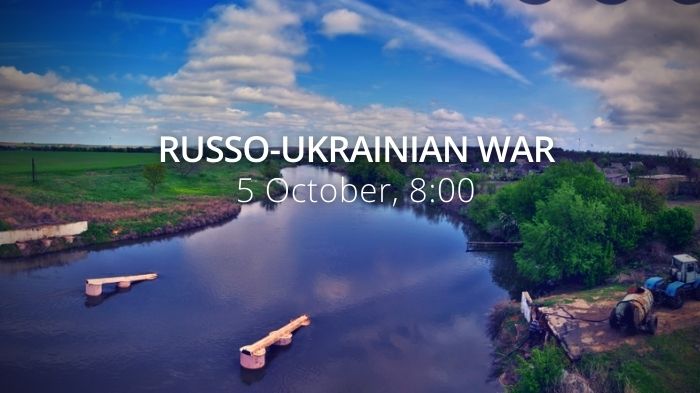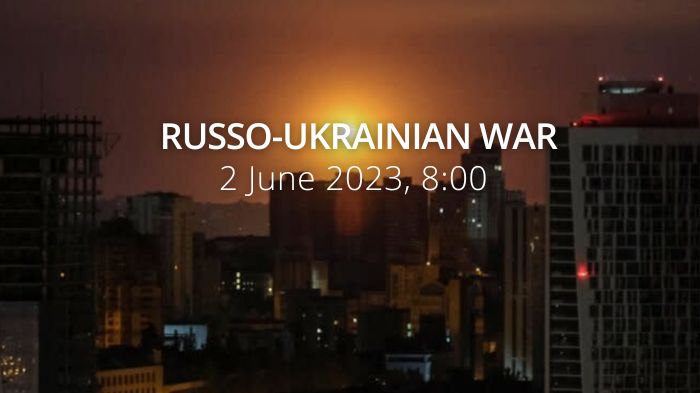Luhansk Oblast is the hottest spot of the war as Russia continues battle for Sievierodonetsk. Small Russian advances at Izium. Russian forces may be preparing an offensive in Zaporizhzhia and Kherson oblasts. Russia has deported nearly 1.4 mn Ukrainians to its territory as sanctions severe logistical chains in Russia. Ukraine pushes back calls for a "ceasefire," says it can win war.
Situation
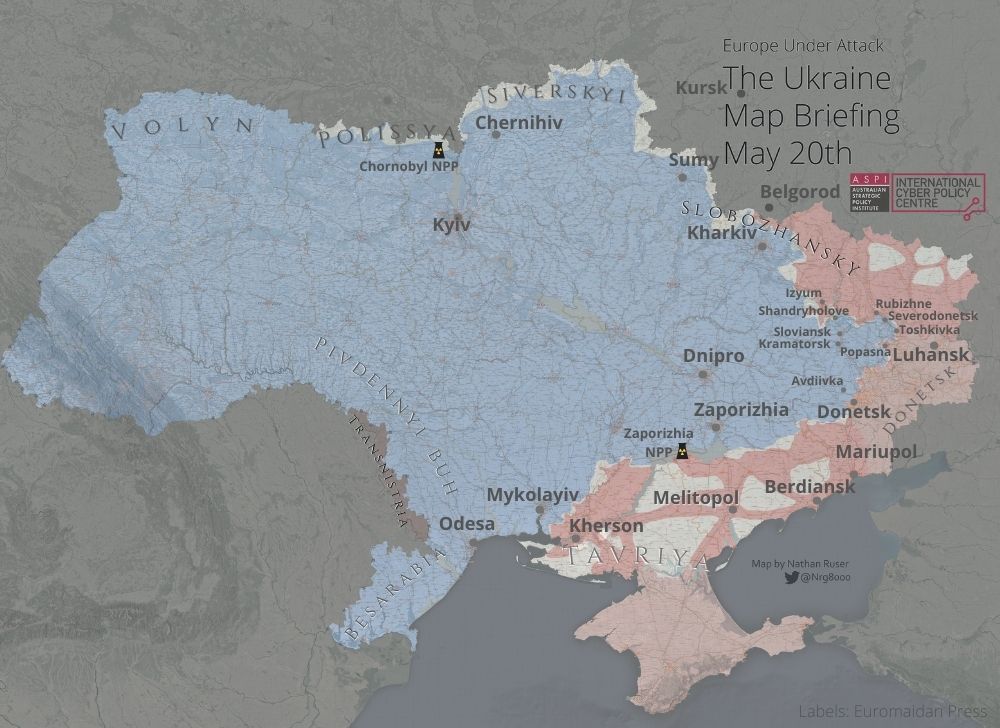
A short overview of developments at the front according to military expert Roman Ponomarenko:
North Ukraine shelled by Russians. Hremiach village (Chernihiv Obl) was shelled with mortars. In Sumy Oblast, MLRS was used to shell the Ukrainian territory. Also, Lukashenka's army has been actively saber-rattling as it concentrates troops and missile units on the northern border. And it even conducts reconnaissance of Ukrainian positions with UAVs; this is more likely to distract, divert Ukrainian reserves, not to invade.
Luhansk Oblast: hottest spot. Russians have deployed considerable forces to seize the last 10% of the region still controlled by Ukraine. Yesterday's battles at Sievierodonetsk and Lysychansk, as well as around Popasna, from where the enemy seeks to advance in three directions at once - north, west, and south, continue.
https://twitter.com/EuromaidanPress/status/1528255721640452096
In the northern axis, the Russians avoid fighting for fortified villages (Komyshuvakha, Katerynivka, Hirske) and move past them to Lysychansk. May 20's Russian statements about cutting the Soledar-Lysychansk road haven't been confirmed, although the threat remains and the route itself has been under fire.
In general, the Armed Forces of Ukraine perform miracles in this area is extremely difficult conditions.
In the coming days, Russia will continue to increase attacks in Luhansk Oblast, helped by a developed railway network in this sector, which is used to deliver ammunition directly to the front.
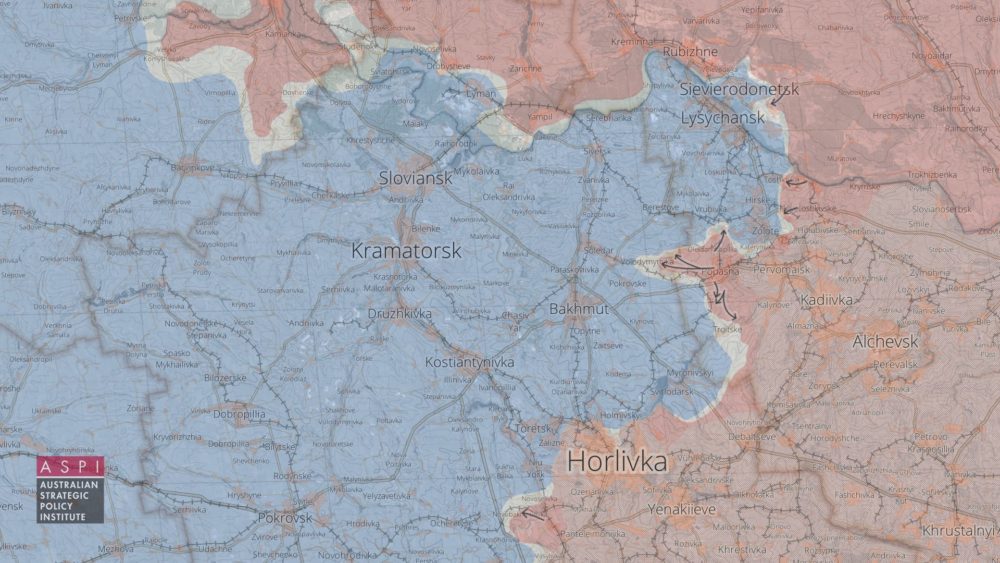
According to the oblast's head Serhii Haidai, its task is to deter the Russians for as long as possible, as a Ukrainian counterattack may begin in June. That is why minor tactical setbacks for Ukraine here now do not mean Ukraine is globally losing.
https://twitter.com/War_Mapper/status/1527806782554443776
No special changes in other sectors of the front. In Kharkiv Oblast, the front line stabilized on the approaches to the Russian border. Ukraine lost Ternova under Russian attacks by an entire BTG (battalion-tactical group) of the 200th Motor-Rifle Brigade, as well as Rubizhne.
Hostilities also continue in the Veselyi area. The enemy continues shelling and bombing Kharkiv. Near Izium, the Russians built another pontoon bridge across the Siverskyi Donets, near Yaremivka, trying to develop an offensive on Sviatohirsk.

The situation in Donetsk Oblast has not changed either; Russia attacked near Mariinka, Avdiivka, and Novomykhailivka, but to no avail.
According to the General Staff, nothing significant has happened in Zaporizhzhia, Kherson, and Mykolaiv oblasts.
Situation in general. Overall, news about Ukraine losing a settlement or a city is no reason for panic; the area is well-fortified, and Russians won't have a powerful breakthrough, like the one that made Mariupol find itself in the enemy's rear.
Morning report day 88 – May 22
The full information from the General Staff as of 06.00 22.05.2022, supplemented by its [18:00 assessment], is the drop-down box below.
“Russian forces do not stop conducting offensive operations in the Eastern Operational Zone.
Russian forces continue to launch missiles and airstrikes on the territory of Ukraine. Increased the intensity of the use of aircraft to destroy the critical infrastructure of settlements in the area of active hostilities.
In the Volyn and Polissia directions, units of the Armed Forces of the Republic of Belarus have intensified reconnaissance and the deployment of additional means of electronic reconnaissance in the border areas of the Gomel region has been noted. There is still a threat of missiles and airstrikes from the territory of the Republic of Belarus on objects on the territory of Ukraine.
In the Siverskyi direction, Russian forces continue to shell settlements and infrastructure in Sumy and Chernihiv oblasts. It carried out shelling in the areas of Boyaro-Lezhachi, Ulytsia, Bunyakine, Hirky, Gremyach and Muravyi.
- [Yesterday, they fired on the settlements of Semenivka, Bleshnya, and Hirsk in the Chernihiv oblast. It fired missiles at targets in Zhytomyr and Poltava regions.]
In the Slobozhanskyi direction, Russian forces, by forces of separate units of the 6th Combined Arms Army of the Western Military District and the Baltic Fleet, are fighting to maintain the occupied borders in the Kharkiv direction and prevent our troops from entering the state border.
- [Yesterday, Russian forces launched airstrikes and fired artillery at the areas of the settlements of Chornohlazivka, Prudyanka, Dementiivka and Ternova.]
- Russian forces are preparing to resume the offensive in the Sloviansk direction. The occupiers carried out artillery shelling in the areas of the settlements of Vernopil, Dibrivne and Dovhenke. [During Saturday, Russian forces carried out artillery shelling in the areas of the settlements of Velyka Komyshuvakha and Dovhenke in the Kharkiv region.]
- In the Belgorod region, Russian forces deployed launchers of the Iskander-M operational-tactical missile system. In addition, Russian forces are increasing the system of logistics and repair bases.
In the Donetsk direction, the occupiers are trying to break through the defense of our troops and reach the administrative borders of the Luhansk region.
- Russian forces carried out airstrikes on civilian infrastructure in the areas of Vrubivka and Bakhmut.
- Russian forces did not conduct active hostilities in the Lyman direction. It fired on infrastructure facilities in the area of the settlements of Lyman, Ozerne, Zakitne, Dibrova and Serebryanka.
- In the Sievierodonetsk direction, Russian forces fired on the positions of the Defense Forces along the entire line of contact with mortars and artillery, concentrating efforts in the direction of the settlements of Sievierodonetsk and Lysychansk. Russian forces conducted offensive and assault operations in the areas of Oskolonivka, Purdivka, Shchedryshcheve and Smolyaninove. The offensive was repulsed and Russian forces suffered losses and were forced to retreat to the old positions.
https://twitter.com/EuromaidanPress/status/1528255721640452096
- In the Bakhmut direction, with the support of artillery, Russian forces tried to improve the tactical situation in the areas of the settlements of Trypillya, Lypove and Vasylivka and fighting continues.
- In the Avdiivka direction, Russian occupiers suffered losses in the area of the settlement of Krasnohorivka.
- In the Kurakhove direction, Russian forces stormed the Mariinka area and were unsuccessful. It fired on Novomykhailivka and Volodymyrivka. It launched airstrikes on the settlements of Mykilske and Katerynivka.
- [Russian forces inflicted an airstrike on the settlement of Mykilske, Volnovakha district, Donetsk oblast.]
- In the Novopavlivsk and Zaporizhzhia directions, Russian forces tried to gain a foothold on the occupied frontiers, shelling the positions of the Defense Forces and civilian infrastructure. [Saturday they carried out shelling of civilian infrastructure in the settlements of Vremivka, Donetsk oblast, Olhivske, Zatyshshya, Huliaypole, Orikhove, Novodanylivka and Kamyanske, Zaporizhzhia oblast.]
- In the past 24hrs, nine enemy attacks have been repulsed in the Donetsk and Luhansk directions, five tanks, four artillery systems, ten units of armored combat vehicles and two enemy vehicles have been destroyed. Air defense units hit one Orlan-10 UAV.
Russian forces did not conduct active hostilities in the Pivdennyi Buh direction. Focuses its main efforts on maintaining occupied frontiers, conducting reconnaissance and engineering activities of positions. It shelled the positions of the Defense Forces with mortars and artillery. Increases the air defense system.
- The situation in the Besarabian direction has not changed.
Anti-aircraft missile units of the Air Force shot down two cruise missiles and strike aircraft destroyed twelve units of enemy military equipment.
[The Command of the Occupying Troops of the Russian Federation continues to carry out covert mobilization measures to replace servicemen who have suffered casualties outside the territory of Ukraine. Work is underway to attract persons who are on temporarily occupied by Russian occupiers territories of Ukraine to the ranks of the armed forces of the aggressor's troops. To strengthen the groups, the Russian forces form reserves from the 36th Combined Arms Army of the Eastern Military District and actively use military transport aircraft to transfer manpower and logistics to the areas bordering Ukraine.]
[At the same time, Russian occupation authorities are working on the so-called "nationalization" of telecommunications companies.]
[Russian forces suffer numerous losses in the war on the territory of Ukraine.]”
700,000 soldiers are defending Ukraine today, the Ukrainska Pravda reports. In an interview with Ukrainian journalists, President Zelenskyy said today that Ukraine is being defended in the war by 700,000 military personnel. He added that this number of people and equipment is scattered throughout the country. According to CEPA, the most recent numbers from the beginning of 2021 show that women make up 22.8% of the armed forces. [700,000 is not number of Ukrainian troops at the front. Most likely, the president meant the total number of servicemen of the Armed Forces and potential reservists. For example, BBC says that the number of the armed forces of Ukraine is now 261,000 people, but, according to the Minister of Defense, another 100,000 are members of the territorial defense units. - Ed]
Ukraine’s forces destroy a Russian enemy pontoon bridge over Siverskyi Donets, the Ukrinform reports. "The Russians planned to redeploy personnel and armored vehicles across a pontoon crossing over the Siverskyi Donets River near Serebryanka. But the Russians forcing the river is ‘mission impossible’ due to 30 SMB soldiers and other security forces,” a statement from the 30th Separate Mechanized Brigade reads.
Russians fire with "Grads" for more than an hour on the Sumy region, the Ukrainska Pravda reports. As of 15:30 Saturday, for more than an hour, Russian occupiers fired from "Grad" multiple rocket launchers at settlements in the Sumy region, according to both Dmytro Zhyvytskyi, the Head of Sumy Oblast Military Administration and the State Border Guard Service of Ukraine. The Head of Sumy Oblast Military Administration also claims that at about 9:00 a.m., Russian occupiers fired artillery at the Bilopilska amalgamated territorial community (hromada) from the territory of Belgorod Oblast, Russia.
Russians fire mortars on border areas of the Chernihiv oblast, the Ukrinform reports. "The occupiers continue to fire on the border areas of the Chernihiv oblast. At about 12:10-12:20, observers recorded nine shellings from, probably, a 120mm mortar towards Hremyach, the Operational Command "North" posted on
Facebook. At about the same time, six attacks towards Mykolayivka, probably, from 120mm mortar or tube artillery, were recorded.”
Russians threaten to fire on a civilian vessel in Ukrainian territorial waters, the Ukrainska Pravda reports. "This morning, the civilian vessel Britta K, under the flag of the Republic of Togo, which was making a transit passage through Ukrainian territorial waters near Zmiinyi (Snake) Island, received a signal from the Russians demanding that it leave the territorial waters of the Russian Federation, otherwise weapons would be used on it," according to the Naval Forces of the Armed Forces of Ukraine. In an audio recording posted by the Ukrainian Navy, a Russian military officer warns the ship's helmsmen that they are allegedly sailing in Russian territorial waters, although the map shows that the ship is in waters that are considered Ukrainian by international treaties.”
Fire Erupts at a Russia Aviation Institute Near Moscow as Ukraine War Rages, the Newsweek reports. “A fire broke out Saturday at a renowned aviation institute in the Moscow region in the latest Russian blaze that has been shared on social media. The institute has been a state research centre since 1994 and its website describes it as the largest scientific research centre in the world. The centre is helping to develop next-generation jet airliners such as the new Ilyushin Il-96 and the Tupolev Tu-204, the website said.
A cause for the fire has not been listed but it is the latest blaze in Russia that has made headlines since the start of the Ukraine war. This week, responders tackled a fire that covered around 22,000 square feet at an industrial site in Berdsk, near Siberia's largest city of Novosibirsk, around 1,800 miles east of Moscow. Local officials said the fire was sparked by polyethylene products on the first floor of the building. Earlier this month, an explosion in the gunpowder warehouse of a military unit in the Amur district of the Khabarovsk region killed one person and injured seven others. It came only days after two fatalities were reported following a major explosion at an ammunition plant that produces gunpowder in the city of Perm, near the Ural Mountains in Russia. Days later a fire engulfed an aviation college in the same city. There have been a number of fires reported in Russian areas bordering Ukraine which have sparked speculation they were linked to hostilities in the war, including several blazes in the Belgorod region.”
Additional restrictions were introduced in three districts of the Odesa region, the Ukrainska Pravda reports. Within the Odesa, Belgorod-Dnistrovskyi and Bolhrad border districts of Odesa Oblast (Besarabia direction), additional temporary restrictions on entry, carrying out works, navigation, etc. were introduced. It is reported that the restrictions were imposed due to armed aggression by the Russian Federation to take measures to strengthen national security and the defense of Ukraine. A list of all restrictions can be found in greater detail on the SBGS website and on the relevant Google map showing the boundaries of the area where the restrictions apply.
According to British Defence Intelligence, (last 24 hours):
- Russia’s only operational company of BMP-T Terminator tank support vehicles has likely been deployed to the Sievierodonetsk axis of the Donbas offensive.
- Their presence suggests that the Central Grouping of Forces (CGF) is involved in this attack, which is the only formation fielding this vehicle. CGF previously suffered heavy losses while failing to break through to eastern Kyiv in the first phase of the invasion.
- Russia developed Terminator after identifying the need to provide dedicated protection to main battle tanks it used during the Afghan and Chechen wars. The Sievierodonetsk area remains one of Russia’s immediate tactical priorities. However, with a maximum of ten Terminators deployed they are unlikely to have a significant impact on the campaign.
As of Sunday 22 May, the approximate losses of weapons and military equipment of the Russian Armed Forces from the beginning of the war to the present day:

Russian enemy suffered the greatest losses (of the last day) in the Bakhmut direction.
A month ago, Ukrainska Pravda reported that Russia had already lost 3.5 times more equipment than Ukraine, citing Oryx. Making up status one month later, we find that Russia has already lost 3732 (+730) units of equipment, of which: were destroyed: 2075 (+487), damaged: 74 (+27), abandoned: 290 (+46) and captured: 1293 (+170). Ukraine, meanwhile, has lost 1063 (+215) units of equipment, of which were destroyed: 497 (+108), damaged: 25 (+3), abandoned: 35 (-1), captured: 506 (+105). The numbers confirm that Russia keeps losing 3,5 more equipment than Ukraine.
Humanitarian
Russia has deported 1,377,925 people to its territory, including 232,480 children as of the morning of May 21, the Ukrinform reports. "Over the last day - 17,306, including 2,213 children," the Ukrainian Parliament Commissioner for Human Rights, Liudmyla Denisova, announced wrote on Telegram. Denisova stressed that Russian claims about Ukrainians' voluntary resettlement are false. Ukraine has indisputable evidence of forced and pre-planned deportation.
The ombudsperson said that the footage showed a real picture of the deportation of Mariupol residents: people surrounded by Russian soldiers armed with rifles, outraged and scared. The Russian invaders do not allow people to leave the site of the so-called "evacuation". Ukrainians are forced to board buses and only then are they told that they will be taken to a "filtration camp" in the village of Bezimenne, Novoazovsk district and then – to Russia.
The ombudsperson stressed that Russia's actions grossly violate Article 49 of the Geneva Convention relative to the Protection of Civilian Persons in Time of War, which prohibits the forced relocation or deportation of persons from occupied territories. Deportation and forced displacement are crimes against humanity under Article 7 of the Rome Statute of the International Criminal Court, Denisova added.
According to
UNHCR 6,444,009 refugees have been registered as of May 20. The UN says that so far Poland has taken in 3,463,320 refugees, Romania 943,015, Russian Federation 887,651, Hungary 633,219, Republic of Moldova 468,998, Slovakia 435,660 and Belarus 27,308. Among those who fled Ukraine are also Ukrainian nationals with dual citizenship. An additional 105,000 people moved to the Russian Federation from Donetsk and Luhansk oblasts between 18 and 23 February.
The number of Ukrainians entering Ukraine since February 28 is 1,963,500 as of May 20. This figure reflects cross-border movements, which can be pendular and does not necessarily indicate sustainable returns.
OHCHR recorded 8,189 civilian casualties in Ukraine as of May 19. 3,838 were killed (including 256 children) and 4,351 injured (including 383 children).
Legal
Almost 4,000 men from Mariupol are held in ‘filtration camps’ in the occupied Donetsk region, the Ukrinform reports. “The occupiers increase the pace of deportation of men from bombed Mariupol to ‘filtration camps’. Currently, according to rough estimates, there are almost 4,000 men in such camps in Bezimenne and Kozatske, Novoazovsk district, Donetsk region, Ukrainian Parliament Commissioner for Human Rights Liudmyla Denisova posted on Telegram.
The Commissioner added that the number of Ukrainian men in "filtration camps" had doubled over the past two weeks alone. None of those detained in the camps returned. The men are held in horrible conditions. They sleep on the floor in unbreathable and unsanitary [rooms]. They are subjected to torture and abuse.
The occupiers claim that these men will be ‘mobilized’ to join the ranks of illegal armed formations in certain areas of the Donetsk region in July-August. To do this, our citizens are forced to write applications for acquiring the citizenship of a self-proclaimed pseudo-Republic or Russia, Denisova noted. She called on the UN Commission of Inquiry on Ukraine to take into account these facts of war crimes and human rights violations.”
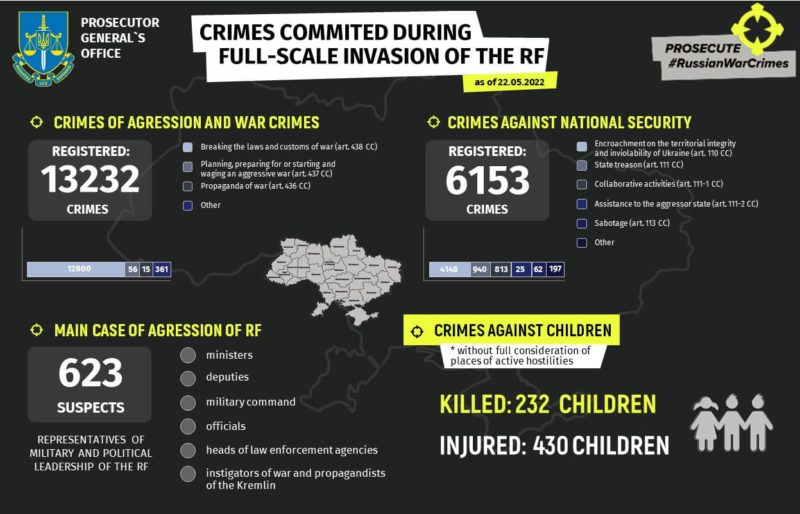 232 children were killed and 430 children injured, the Office of the Prosecutor General of Ukraine reports as of May 22. 1,837 educational establishments are damaged as a result of shelling and bombings, 172 of them are destroyed fully. 13,232 crimes of aggression and war crimes and 6,153 crimes against national security were registered.
232 children were killed and 430 children injured, the Office of the Prosecutor General of Ukraine reports as of May 22. 1,837 educational establishments are damaged as a result of shelling and bombings, 172 of them are destroyed fully. 13,232 crimes of aggression and war crimes and 6,153 crimes against national security were registered.
Support
If the world does not help Ukraine unblock its ports, the energy crisis will be followed by a food crisis, President Zelenskyy said. “The world community must help Ukraine unblock seaports, otherwise the energy crisis will be followed by a food crisis and many more countries will face it. "Russia has blocked almost all ports and all, so to speak, maritime opportunities to export food - our grain, barley, sunflower and more," the Head of State said during a meeting with media representatives.
According to the President, currently, the Russian Federation has blocked 22 million tons of food products. The aggressor country is gradually stealing it and trying to sell it. There will be a crisis in the world. The second crisis after the energy one, which was provoked by Russia. Now it will create a food crisis if we do not unblock the routes for Ukraine, do not help the countries of Africa, Europe and Asia, which need these food products. You can unblock them in different ways. One of the ways is a military solution. That is why we turn to our partners with inquiries regarding the relevant weapons, Zelenskyy added.”
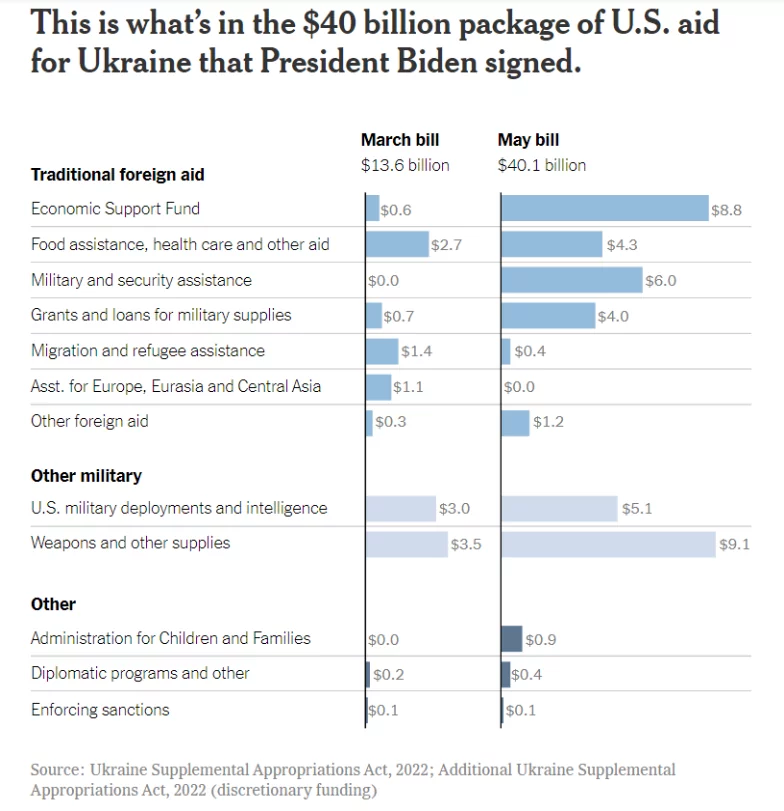 Biden signs Ukraine funding bill, the Reuters reports. “US President Joe Biden on Saturday signed a bill to provide nearly $40 billion in aid for Ukraine as part of efforts to boost military support over Russia's invasion, the White House said”. According to The New York Times, “the $40 billion package of new aid for Ukraine, approved by Congress earlier this week and signed by President Biden on Saturday, brings the total that the United States has pledged toward countering Russia’s invasion to roughly $54 billion, when combined with a smaller package passed in March.
Biden signs Ukraine funding bill, the Reuters reports. “US President Joe Biden on Saturday signed a bill to provide nearly $40 billion in aid for Ukraine as part of efforts to boost military support over Russia's invasion, the White House said”. According to The New York Times, “the $40 billion package of new aid for Ukraine, approved by Congress earlier this week and signed by President Biden on Saturday, brings the total that the United States has pledged toward countering Russia’s invasion to roughly $54 billion, when combined with a smaller package passed in March.
The money in the newly enacted package is nearly evenly divided between military and humanitarian aid. It provides about $6 billion for support, weapons and training for Ukraine’s military and national security forces and $4 billion in grants and loans for military supplies. It authorizes the transfer of $11 billion in American weapons and other military supplies and sets aside $5.1 billion for US military deployments and intelligence. It also earmarks $9 billion in new spending to replace the military equipment sent to Ukraine from American stockpiles.”
On 21 May, Russia sanctioned 963 US government officials and prominent Americans, banning them from entering the country. Seven of them are no longer alive. Moreover, the dates of their death are also on the listhttps://t.co/DUua4cqZVH
— Euromaidan Press (@EuromaidanPress) May 21, 2022
Sanctions severe logistical chains in Russia, transport minister acknowledges, the Ukrinform
reports. “Russia’s Transport Minister Vitaly Savelyev says western sanctions have led to serious problems with logistics across Russia. That’s according to Interfax, Ukrinform reports. The sanctions imposed on Russia as of today have practically broken all logistics in our country. And we have to look for new logistics corridors, the official said during a visit to Astrakhan region. According to the minister, Russian authorities expect to settle the issue with the help of the North-South transport corridor, which passes through the Caspian ports of Astrakhan on the Volga, Olya on the Volga-Caspian Canal and Makhachkala in the Caspian Sea.”
New developments
- The Foreign Ministry confirmed information about Italy's "peace plan" to end the war, the European Pravda reports. "The Italian side has shared its vision of ways to end Russia's war against Ukraine. Relevant proposals are currently being studied. We welcome any international efforts to restore peace on Ukrainian soil and in Europe. At the same time, any political decision must be based on respect for sovereignty and territorial integrity of Ukraine within its internationally recognized borders," Foreign Ministry spokesman Oleh Nikolenko said.
According to the Domani, it has four key points - the cessation of hostilities and the start of negotiations with the assistance of an international assistance group, in which they offer to discuss Ukraine's military neutrality with the support of other countries acting as guarantors and with the possibility of joining EU. It is suggested that all issues of ORDLO and Crimea be discussed separately, although without questioning their belonging to Ukraine. In the fourth point, Italy proposes a new multilateral treaty to maintain peace and security in Europe, which could prevent future conflicts.
- Zelenskyy: We have broken the backbone of one of the strongest armies in the world, the Ukrainska Pravda reports. President Zelenskyy considers the lives of the Ukrainian people to be the most valuable and reiterated his opinion that the return of the territories to the demarcation line as of 23 February 2022 would constitute victory, he said in an interview with journalists on the occasion of the 3rd anniversary of his inauguration. In contrast, the Foreign Minister of Ukraine, Dmytro Kuleba, on Thursday said Ukraine should have Donbas and Crimea returned to win the war.
- Victory can be achieved only in battle and fixing the end of the war will still be diplomatic, Volodymyr Zelenskyy states. Ukraine can win the war with Russia only on the battlefield, but the final dot will still be put at the negotiating table. There are several issues that can only be resolved at the negotiating table, including the issues of the end of the war and the establishment of peace, de-occupation of Ukrainian territories and exchange and return home of Ukrainian military and civilians.
- Ukraine to define when and how the war ends – FM Kuleba, the Ukrinform reports. “Ukraine and only Ukraine, will define when and how the war ends. We exercise our right to self-defense under Article 51 of the UN Charter, following a brutal armed attack. President Zelenskyy has been clear. We don’t need anyone else’s land, but we won’t give up on what’s ours, Kuleba stressed. The relevant statement was made by Ukrainian Foreign Affairs Minister Dmytro Kuleba on Twitter.”
- Podoliak on "sacrificing territories": this is what a loser says, who has already lost in his heart, the Ukrainska Pravda reports. Responding to the article “The War in Ukraine Is Getting Complicated and America Isn’t Ready,” from the Editorial Board of The New York Times, the head of the Office of the President of Ukraine, Mykhailo Podoliak stated on Twitter that he does not consider it impossible for Ukraine to win the war with Russia and regain the territories occupied by the Russians. "According to experts, Ukraine should have frozen three times in winter, run out of electricity in March and the Russian flag would have already flown over half of the country. Remember this when you hear another horror story that the country will not survive next winter and people will be left on the streets without work. If we gave up every time someone said "it is impossible," we would no longer have a country. If you hear "Ukraine will have to sacrifice territories because Russia is strong," this is said by a loser who has already lost in his heart. We have no other country, we know what we are fighting for. That's why we will win."
- Secretary of Defense Lloyd J. Austin III will host a second meeting of the Ukraine Contact Group on Monday, Pentagon Press Secretary John F. Kirby said today, the US Department of Defense stated. “The group is composed of nations dedicated to aiding Ukraine in its fight against Russian invaders. Austin first convened the group at Ramstein Air Base, Germany last month. Before the virtual meeting, Austin will speak with Ukrainian Defense Minister Oleksii Reznikov, to discuss Ukraine's military requirements, Kirby said. "The contact group meeting will include over 40 countries, Kirby said. These are all countries that provide security assistance to Ukraine and they will discuss what Ukraine will need in the future.”
- Gazprom confirms the stop of Russia’s natural gas supplies to Finland, the TASS reports. "Gazprom has cut off its gas supplies to Gasum (Finland) due to a failure of the latter to pay for the gas deliveries in rubles," the statement reads. "As of the end of the workday on May 20, Gazprom Export did not receive a payment from Gasum for gas deliveries in April in line with the [Russian] presidential order…"
Assessment
On the War
The Institute for the Study of War has made the following assessment as of Saturday 21 May:
 Russian forces made small advances southeast of Izium on May 21. Footage posted by the Donetsk People’s Republic (DNR) on May 21 showed DNR forces examining a destroyed dam in Oskil, about 10 km southeast of Izium, suggesting that Ukrainian forces likely withdrew from the settlement across the Oskil River. The Ukrainian General Staff reported that Russian forces around Izium are preparing to resume an offensive in the direction of Sloviansk. Russian forces additionally shelled Velyka Komyshuvakha to the southwest of Izium and Dovehenke to the southeast of Izium, indicating they plan to continue offensive operations to the south of Izium.
Russian forces made small advances southeast of Izium on May 21. Footage posted by the Donetsk People’s Republic (DNR) on May 21 showed DNR forces examining a destroyed dam in Oskil, about 10 km southeast of Izium, suggesting that Ukrainian forces likely withdrew from the settlement across the Oskil River. The Ukrainian General Staff reported that Russian forces around Izium are preparing to resume an offensive in the direction of Sloviansk. Russian forces additionally shelled Velyka Komyshuvakha to the southwest of Izium and Dovehenke to the southeast of Izium, indicating they plan to continue offensive operations to the south of Izium.
Russian forces made gains in the Rubizhne-Sievierodonetsk-Lysychansk area and intensified efforts to capture Sievierodonetsk on May 21. Russian troops blew up a bridge across the Siverskyi Donets River between Sievierodonetsk and Lysychansk, setting conditions to sever Ukrainian ground lines of communication (GLOCs) and take Sievierodonetsk.
Russian forces may be preparing for an offensive to capture the remainder of northern Kherson Oblast and push toward Zaporizhzhia City despite not making any confirmed advances on the southern axis on May 21. The Kherson Regional State Administration stated that Russian troops are replenishing their grouping in Vysokopillyya and Arkhangelske, northern Kherson Oblast, in anticipation of increased combat activity in the area of the Kherson-Mykolaiv Oblast border. The Zaporizhzhia Regional Military Administration noted that there is a high concentration of Russian forces in Inzhenerne, south of Huliapole, indicating that Russian troops are potentially preparing for continued offensives toward Huliapole. The Zaporizhzhia Regional Military Administration claimed that occupying forces in Melitopol are hanging banners to celebrate the 220th anniversary of the Taurida Governate, which may indicate Russian forces intend to make occupied areas in Kherson and Zaporizhzhia a quasi-Republic like the LNR or DNR, but also emphasizes lack of consistency in handling occupation agendas across Ukraine.
Key Takeaways
- Russian forces are conducting operations to cut off Ukrainian ground lines of communication (GLOCs) between Sievierodonetsk and Lysychansk across the Siverskyi Donets River.
- The information space in Mariupol will likely become increasingly restricted in the coming weeks as Russian forces shift focus from completing the capture of the Azovstal Steel Plant to consolidating occupational control of the city.
- Russian troops are likely reinforcing their grouping around Kharkiv City to prevent further Ukrainian advances toward the international border.
- Russian forces may be assembling forces in certain areas of Zaporizhzhia and Kherson oblasts to initiate further offensive operations on the southern axis.“
Consequences and what to do?
As Biden Signs $40 Billion Aid Package for Ukraine, Calls Grow for a Cease-Fire, The New York Times reports. The following is an extract from the article:
The war is now set to enter its fourth month and while Moscow has been forced to retreat first from outside the capital, Kyiv and more recently from the country’s second-largest city, Kharkiv, neither side is currently making more than incremental gains.
With the conflict coming ever closer to a stalemate and both sides fighting in the Donbas region to gain the upper hand, calls for a cease-fire have grown louder, along with questions about what would constitute victory, or at least a suitable outcome, for Ukraine.
“A cease-fire must be achieved as soon as possible,” the Italian prime minister, Mario Draghi, urged on Thursday, opening a parliamentary debate on Italy’s role in backing Ukraine. He added that “we have to bring Moscow to the negotiating table.”
German, French and Italian suggestions of a cease-fire have been rejected angrily and even bitterly by Kyiv as selfish and poorly timed. Ukrainian officials say that Russia is hardly ready for serious peace talks and that their forces — despite considerable losses in the Donbas and in Mariupol — have the momentum in the war.
For now, some in Ukraine are insisting that the only outcome it will abide is the restoration of all territory lost to Russia since 1991, when it gained independence from the Soviet Union. That would include both the Donbas in its entirety and Crimea, which Russia annexed in 2014. But Mr. Zelenskyy has hinted that he would accept the status quo ante before the war.
On Friday, the US ambassador to NATO, Julianne Smith, speaking at a conference in Warsaw, restated the United States’ firm support of Ukraine. “In terms of the end state,” she added, “we believe we will see Ukraine prevail and we want them to protect their territorial integrity and their sovereignty.” But she added another objective: “We want to see a strategic defeat of Russia. We want to see Russia leave Ukraine.”
For Eastern European and Baltic leaders, a durable peace settlement and an end to the conflict have to include a crushing military victory that spells an end to Mr. Putin’s presidency. Anything short of his departure would merely pave the way for the next war, they say. They balk at suggestions from Berlin, Paris and Rome to lure Mr. Putin back to the negotiating table.
“Peace can’t be the ultimate goal,” Prime Minister Kaja Kallas of Estonia recently told The New York Times. “I only see a solution as a military victory that could end this once and for all and also punishing the aggressor for what he has done.” Otherwise, she said, “we go back to where we started — you will have a pause of one year, two years and then everything will continue.”
“All these events should wake us from our geopolitical slumber and cause us to cast off our delusions,” Prime Minister Mateusz Morawiecki of Poland said on Thursday at the Warsaw conference. “I hear there are attempts to allow Putin to somehow save face in the international arena. But how can you save something that has been utterly disfigured?” “Russia can only be deterred by our unity, military capabilities and hard sanctions,” he added. “Not by phone calls and conversations with Putin.”
ME: This can be seen as a follow-up on it its Op-ed “The War in Ukraine Is Getting Complicated and America Isn’t Ready”, in which it argued that “a decisive military victory for Ukraine over Russia, in which Ukraine regains all the territory Russia has seized since 2014, is not a realistic goal” and that “Ukrainian leaders will have to make the painful territorial decisions that any compromise will demand”.
The New York Times claims President Zelenskyy “acknowledged that ultimately the conflict would require a diplomatic solution, raising questions about exactly what that would mean,” when he on his official website (referring to the same event) in fact called for a decisive victory and explained exactly what the diplomatic element meant. The headline on President Zelensky’s official website in contrast reads “Victory can be achieved only in battle and fixing the end of the war will still be diplomatic”.
ME: Russia is trying to destroy the Ukrainian nation and undermine the state by changing the demography of Ukraine. This effort started more than 8 years ago but has accelerated because of the full-scale invasion on 24 February. Some of the evidence of its efforts are clear to see by most. The world has already witnessed some of its gross atrocities against unarmed civilians and several institutions are openly accusing Russia of war crimes.
The war itself contributes both directly and indirectly to change the demography of Ukraine. It has created the biggest refugee crisis in Europe since WW2.
A national survey from April 2021, found that 23% of Ukraine's adult population wanted to change their country of residence. The rate of those wishing to leave Ukraine among men and women was almost identical: 24% and 22% respectively. After more than 7 years of war, 57% of adult Ukrainians surveyed feared Putin would seize more territory (and they were proven right on 24 February). While the war was seen as the main factor for the desire to leave, frustration over the lack of reform and, therefore, the lack of prospect for an improved standard of living has previously also been seen as a factor.
According to the UNHCR, nearly 6,5 million Ukrainians, mainly women and children, have already left the country. While nearly 80% have indicated that they want to return, those numbers might decline as Ukrainian infrastructure is being destroyed. Additionally, those who plan to stay abroad will expect their spouses to join them.
These numbers wanting to return might decrease as large areas are being devastated by the war. Ukraine will need a decade to rebuild industry, schools, hospitals, residential areas and other critical infrastructure. A decade is a lifetime for young people trying to establish themselves and care for their families. No one will return to areas that remain under Russian occupation. The fact is that many of those who are trapped behind the frontline try to leave but are denied by the Russian occupation forces.
Additionally, Russia has allegedly forcibly deported 1,377,925 people to its territory. These numbers include 232,480 children. The Economist reports that “filtration camps”, a tool of terror used since the 1940s, have reappeared.
“Before Russia’s invasion, American officials said that Russian forces were creating lists of people to be killed or sent to camps if Russia occupied parts of the country. Likely targets included Russian and Belarusian dissidents in exile, anti-corruption activists, members of religious and ethnic minorities and LGBT people. […] [Escapees tell a story, comparing] conditions to those of a ghetto or concentration camp. They claim to have witnessed torture and killings carried out by Russian security services to weed out “Ukrainian Nazis”.
According to the UN, the deportation or transfer of people from an occupied territory constitutes a war crime. Russia insists that the relocation of civilians by its armed forces is benign and voluntary. But filtration camps appear to be a tool of war, used to erase Ukrainian identity.”
Russia sends relatives of Ukrainian soldiers and other Mariupol residents to ‘concentration camp’ in occupied Donbas, the Kharkiv Human Rights Protection Group wrote.
We have seen claims that Russia might be in the process of triggering “ yet another hunger catastrophe (Holodomor) in the occupied territories. According to the Head of Luhansk Regional Military Administration, Serhii Haidai, Russians want to engineer famine in Luhansk Region as several grain elevators have been destroyed and crops are stolen. His observations and conclusion were in line with the editorial of Sergiy Sydorenko, the Editor for European Pravda under the headline “No Peace Deal is Possible After Red Lines Are Crossed in the Russia-Ukraine War”.
Russia is allegedly also forcibly mobilising Ukrainians to be sent to the frontline as canon-fodder and perversely, to be forced to fight their countrymen.
All of these factors will in the end define the future demography of Ukraine. If Russia is not defeated but offered concessions to make it stop fighting, Ukrainians will know that they have been offered temporary relief only. They have, after all, empirical data proving this to be the fact. It will only be a matter of time before Russia continues its hybrid war to destabilize and undermine Ukraine from within. Anything but defeat and full withdrawal will not only undermine the Ukrainians' hope for a future, but also that of foreign investors.
Russia is changing the demography in Ukraine. Its impact will be long-lasting and increase in scope the longer the West allows the war to continue. It is a threat to both the Ukrainian nation and the state.


